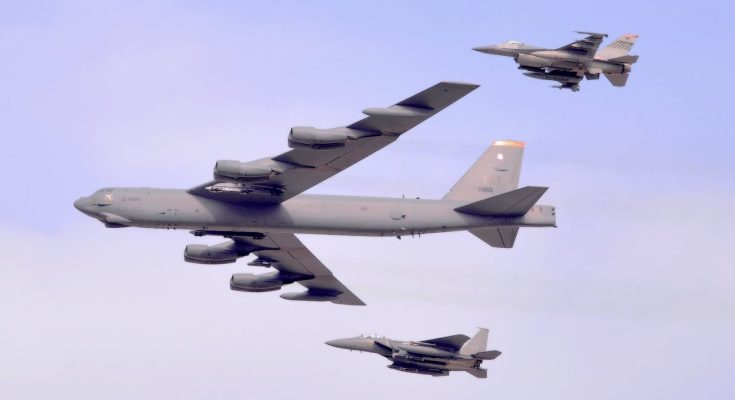South Korea & U.S. Aircraft Show of Force: B-52, F-16, F-15 Low-Level Flight
In a dramatic display of military cooperation and strength, the United States and South Korea recently conducted a joint show of force featuring high-performance aircraft such as the B-52 Stratofortress, F-16 Fighting Falcon, and F-15 Eagle. This aerial demonstration, which included low-level flights over South Korean airspace, was aimed at showcasing the formidable capabilities of the two nations’ armed forces, reinforcing their alliance, and sending a clear message to potential adversaries about their readiness and resolve.
Aircraft Involved:
- B-52 Stratofortress: The B-52 is a long-range, subsonic strategic bomber developed by Boeing and has been in service with the U.S. Air Force since the 1950s. Known for its versatility, the B-52 can carry both conventional and nuclear weapons, making it an essential part of the United States’ strategic deterrence. In this show of force, the B-52 flew in a formation with other aircraft, demonstrating its ability to conduct long-range missions and provide a potent nuclear and conventional strike capability.
- F-16 Fighting Falcon: The F-16 is a multirole fighter jet that is widely used by the U.S. Air Force and allied nations. Its agility, speed, and ability to perform a wide range of air-to-air and air-to-ground operations make it a versatile asset. In this show of force, the F-16’s low-level flights were particularly significant, as they showcased the jet’s superior maneuverability and ability to evade enemy radar while conducting offensive and defensive operations.
- F-15 Eagle: The F-15 is a renowned air superiority fighter that has been a backbone of U.S. and allied air forces since the 1970s. The F-15’s high-speed performance, long range, and advanced radar capabilities make it highly effective in air-to-air combat. In this joint operation, the F-15 participated in low-level flights to demonstrate its readiness for high-intensity combat, including interception missions, and to enhance the overall strength of the show of force.
Low-Level Flight Maneuvers:
The primary element of this show of force was the low-level flight of these powerful aircraft. Low-level flights are a highly effective way to demonstrate tactical proficiency, as they are difficult for enemy radar systems to detect. This capability is especially important in regions with advanced air defense systems. By flying at altitudes as low as a few hundred feet, these aircraft can simulate evasive maneuvers that would be used in a real combat scenario, showcasing their ability to penetrate heavily defended airspace.
The B-52, flying in coordination with the F-16 and F-15, flew at low altitudes over South Korea to emphasize its ability to execute precision strikes while evading enemy defenses. Meanwhile, the F-16 and F-15 jets conducted tight formations and high-speed maneuvers to demonstrate their dominance in air-to-air combat, further underscoring the U.S. and South Korea’s preparedness for any potential threats.
Purpose and Message:
This joint show of force served multiple purposes. Primarily, it was a demonstration of the military readiness and technological superiority of the South Korean and U.S. forces. In a region fraught with geopolitical tensions, particularly concerning North Korea’s ongoing missile and nuclear weapons development, the exercise was a clear signal of the alliance’s strength and determination.
The low-level flights also symbolized the strategic partnership between the U.S. and South Korea. The two nations have maintained a strong military alliance for decades, and the joint show of force further solidified this relationship. It was a reminder to adversaries, especially North Korea, that any act of aggression or escalation in the region would be met with a powerful, coordinated response from U.S. and South Korean forces.
Regional Implications:
This show of force was particularly significant given the ongoing tensions on the Korean Peninsula. North Korea’s provocative missile tests and belligerent rhetoric have raised concerns in South Korea, the U.S., and neighboring countries. By conducting such a high-profile exercise, the U.S. and South Korea sent a powerful message of deterrence. The presence of advanced aircraft like the B-52, F-16, and F-15 underscored the readiness of the two countries to defend South Korea and uphold regional security.
In addition, this demonstration of force also serves to reassure other regional allies, such as Japan, of the United States’ commitment to the security and stability of the Indo-Pacific region.
Conclusion:
The joint low-level flight exercise featuring the B-52, F-16, and F-15 aircraft was a powerful reminder of the strength of the U.S.-South Korea alliance. It demonstrated the air superiority, versatility, and preparedness of both nations’ military forces, as well as their ability to respond to regional threats effectively. In a volatile region where tensions frequently run high, the display of military readiness serves as both a deterrent and a reassurance, sending a clear message that the U.S. and South Korea stand united in defense of peace and security.



